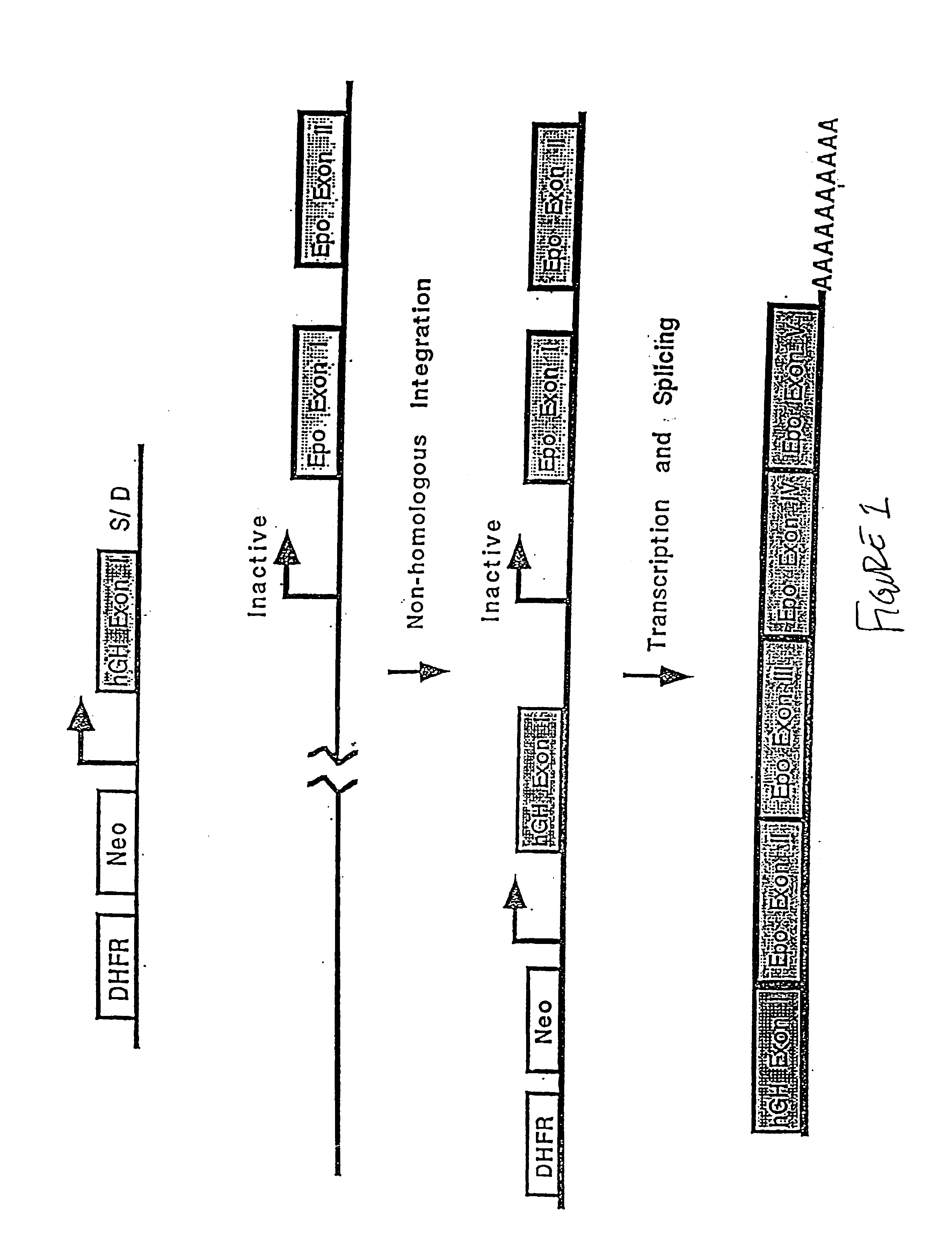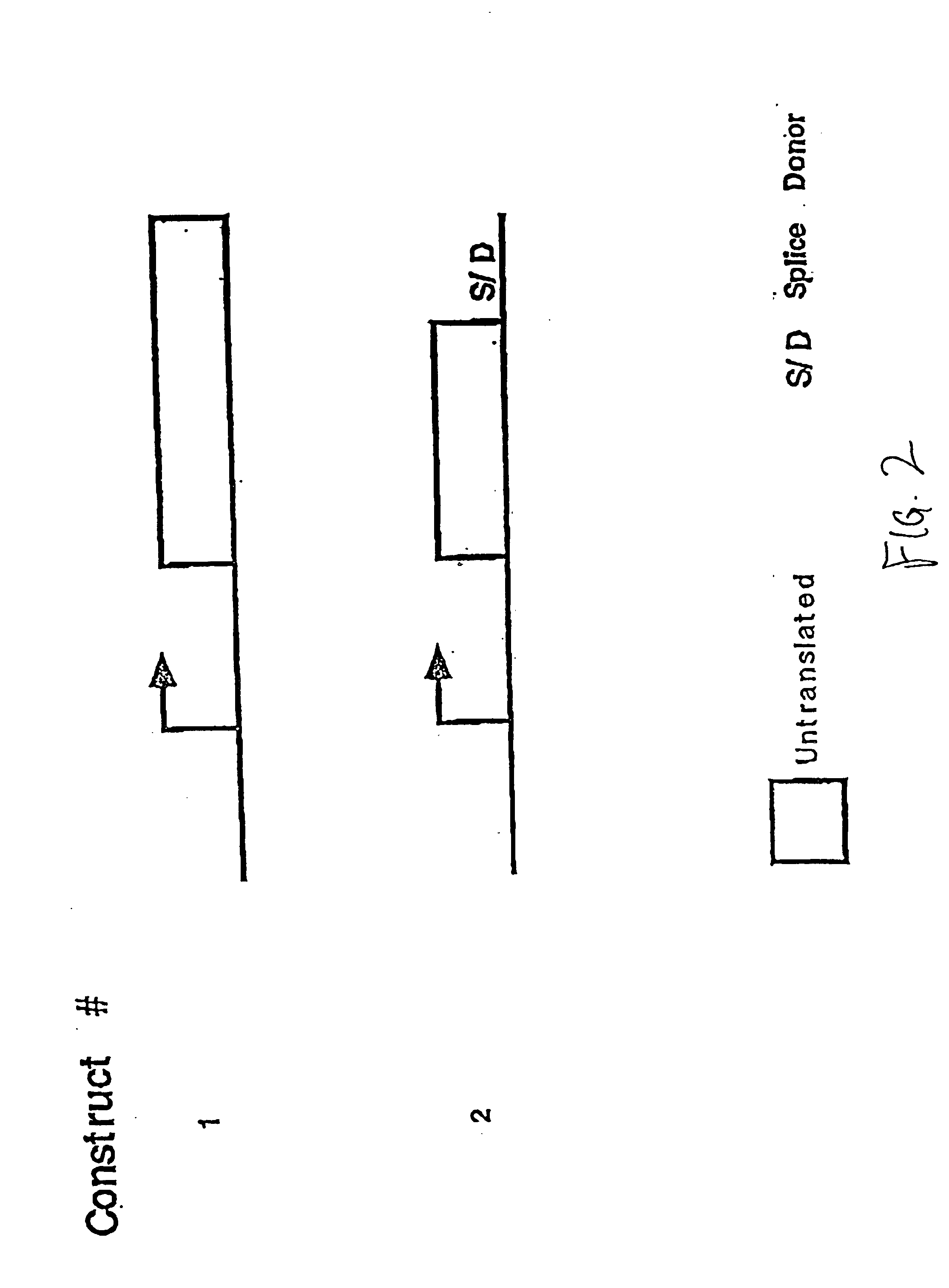Compositions and methods for non-targeted activation of endogenous genes
a technology of endogenous genes and non-targeted activation, which is applied in the field of molecular biology and cellular biology, can solve the problems of difficult or impossible to produce full length cdna molecules capable of expressing biologically active proteins, severely limited use of these vectors to express biologically active mammalian proteins, and limited methods to provide substantially homologous oligonucleotide sequences, etc., to facilitate the purification of that protein
- Summary
- Abstract
- Description
- Claims
- Application Information
AI Technical Summary
Benefits of technology
Problems solved by technology
Method used
Image
Examples
example 1
Transfection of Cells for Activation of Endogenous Gene Expression
Method: Construction of pRIG-1
[0396]Human DHFR was amplified by PCR from cDNA produced from HT1080 cells by PCR using the primers DHFR-F1
[0397](5′ TCCTTCGAAGCTTGTCATGGTTGGTTCGCTAAACTGCAT 3′) (SEQ ID NO:1) and DHFR-R1 (5′ AAACTTAAGATCGATTAATCATTCTTCTCATATACTTCAA 3′) (SEQ ID NO:2), and cloned into the T site in pTARGET™ (Promega) to create pTARGET:DHFR. The RSV promoter was isolated from PREP9 by digestion with NheI and XbaI and inserted into the NheI site of pTARGET:DHFR to create pTgT:RSV+DHFR. Oligonucleotides JH169 (5′ ATCCACCATGGCTACAGGTGAGTACTCG 3′) (SEQ ID NO:3) and JH170 (5′ GATCCGAGTACTCACCTGTAGCCATGGTGGATTTAA 3′) (SEQ ID NO:4) were annealed and inserted into the I-Ppo-I and NheI sites of pTgT:RSV+DHFR to create pTgT:RSV+DHFR+Exl. A 279 bp region corresponding to nucleotides 230-508 of pBR322 was PCR amplified using primers Tet F1 (5′ GGCGAGATCTAGCGCTATATGCGTTGATGCAAT 3′) (SEQ ID NO:5)and Tet F2 (5′ GGCCAGATCTG...
example 2
Use of Ionizing Irradiation to Increase the Frequency and Randomness of DNA Integration
[0400]Method: HH1 cells were harvested at 90% confluency, washed in 1×PBS, and resuspended at a cell concentration of 7.5×106 cells / ml in 1×PBS. 15 μg linearized DNA (pRIG-1) was added to the cells and mixed. 400 μl was added to each electroporation cuvette and pulsed at 250 Volts, 600 μFarads, 50 Ohms using an electroporation apparatus (Biorad). Following the electric pulse, the cells were incubated at room temperature for 10 minutes, and then placed into 2.5 ml αMEM / 10% FBS / 1× penstrep. 300 μl of cells from each shock were irradiated at 0, 50, 500, and 5000 rads immediately prior to or at either 1 hour or 4 hours post transfection. Immediately following irradiation, the cells were plated onto tissue culture plates in complete medium. At 24 hours post plating, G418 was added to the culture to a final concentration of 500 μl / ml. At 7 days post-selection, the culture medium was replaced with fresh ...
example 3
Use of Restriction Enzymes to Generate Random, Semi-random, or Targeted Breaks in the Genome
[0401]Method: HH1 cells were harvested at 90% confluence, washed in 1×PBS, and resuspended at a cell concentration of 7.5×106 cells / ml in 1×PBS. To test the efficiency of integration, 15 μg linearized DNA (PGK-βgeo) was added to each 400 μl aliquot of cells and mixed. To several aliquots of cells, restriction enzymes XbaI, NotI, HindIII, IppoI (10-500 units) were then added to separate cell / DNA mixture. 400 μl was added to each electroporation cuvette and pulsed at 250 Volts, 600 μFarads, 50 Ohms using an electroporation apparatus (BioRad). Following the electric pulse, the cells were incubated at room temperature for 10 minutes, and then placed into 2.5 ml αMEM / 10% FBS1× penstrep. 300 μl of 2.5 ml total cells from each shock were plated onto tissue culture plates in complete media. At 24 hours post plating, G418 was added to the culture to a final concentration of 600 μg / ml. At 7 days post-s...
PUM
| Property | Measurement | Unit |
|---|---|---|
| Volume | aaaaa | aaaaa |
| Volume | aaaaa | aaaaa |
| Volume | aaaaa | aaaaa |
Abstract
Description
Claims
Application Information
 Login to View More
Login to View More - R&D
- Intellectual Property
- Life Sciences
- Materials
- Tech Scout
- Unparalleled Data Quality
- Higher Quality Content
- 60% Fewer Hallucinations
Browse by: Latest US Patents, China's latest patents, Technical Efficacy Thesaurus, Application Domain, Technology Topic, Popular Technical Reports.
© 2025 PatSnap. All rights reserved.Legal|Privacy policy|Modern Slavery Act Transparency Statement|Sitemap|About US| Contact US: help@patsnap.com



